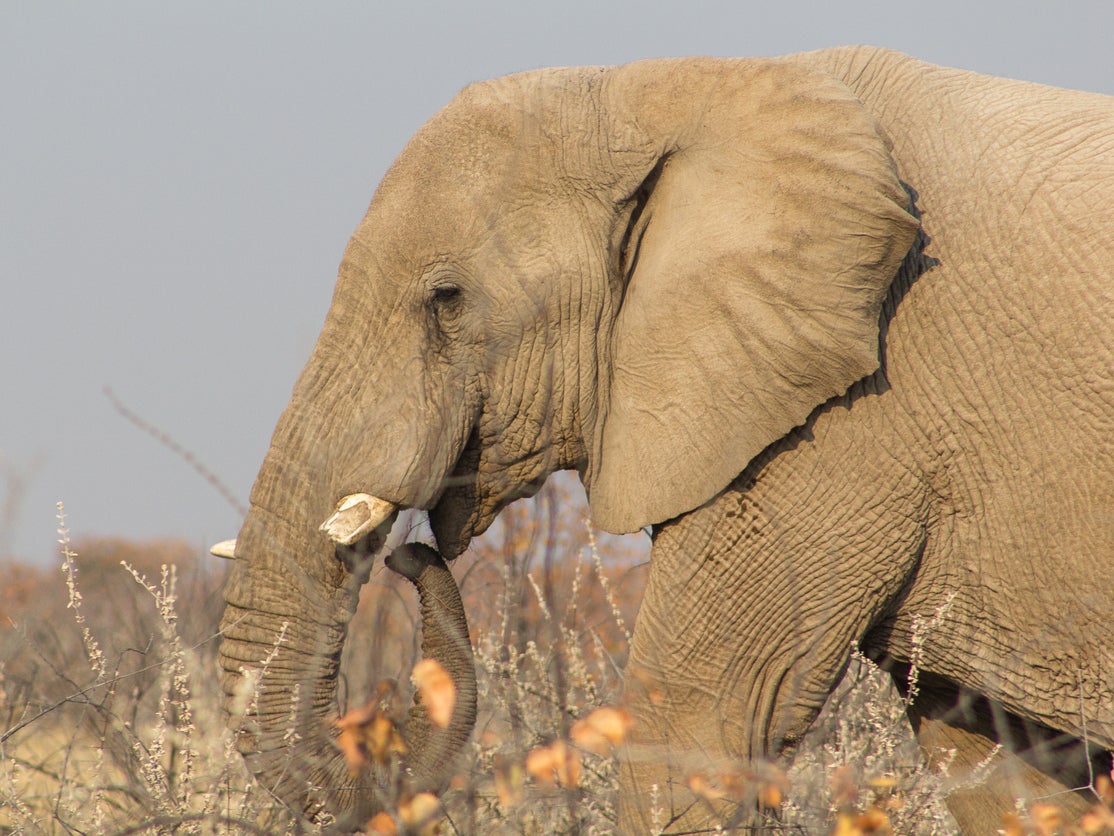This website uses cookies so that we can provide you with the best user experience possible. Cookie information is stored in your browser and performs functions such as recognising you when you return to our website and helping our team to understand which sections of the website you find most interesting and useful.

The global expert who helped draft China’s first animal welfare law has a succinct message for protecting wildlife: “If we don’t buy, they don’t die.”
Grace Ge Gabriel, Regional Director for Asia at the International Fund for Animal Welfare, told The Independent that understanding the driving forces behind the demand for wildlife and their parts was integral to tackling the illegal wildlife trade (IWT).
The Independent’s Stop The Wildlife Trade campaign was launched by its proprietor Evgeny Lebedev to call for an end to high-risk wildlife markets and for an international effort to regulate the illegal trade in wild animals to reduce our risk of future pandemics.
On Wednesday, Ms Gabriel joins the first webinar of The Independent’s campaign to raise awareness around the issue, hosted by non-profit partner Space For Giants’ CEO Max Graham. The panel will explore solutions for preventing the supply of wildlife and their parts from natural habitats to consumer markets.
Illegal wildlife trafficking, worth an estimated $23bn annually, threatens nearly 9,000 species with extinction and for decades has served as a low-risk source of income for criminal organisations and terrorist groups.
Like all trade, it is driven by existing demand and therefore raising awareness among buyers is key.
Ms Gabriel has led global efforts to protect the Tibetan antelope, Asian tigers and Asiatic black bears, along with a campaign to raise awareness among Chinese consumers of the relationship between elephant killing and the ivory trade. In four years, her campaign more than halved the propensity to buy ivory. In 2017, China took the monumental step of banning the elephant ivory trade.
She has been a guest speaker for Interpol on the crisis of global wildlife crime and testified before the EU Commission on protecting wild tigers and the UK parliamentary environmental audit committee.
Ms Gabriel said that illegal trade runs rampant where legal loopholes create the opportunity for it to exist, both in physical markets and online.
“The existence of parallel legal and illegal markets provides laundering opportunities, creates law enforcement difficulties and confuses consumers,” she said.
“This understanding was the reason China banned ivory trade. Banning ivory trade shifts the burden of proof from law enforcers to the criminals, helps stigmatise ivory consumption and creates an enabling social environment for changing consumer behaviour to not buy ivory.”
Demand exists for a number of endangered species, some as delicacies while others are coveted for their medicinal properties or decorative value.
“Before China banned ivory trade, elephant ivory was coveted as having ‘inflation-proof investment value'," Ms Gabriel said.
The plight of the pangolin has been well documented. They remain the world’s most heavily-trafficked mammals, driven by demand for their meat and keratin scales, an ingredient in traditional Chinese medicine.
The status of all eight species of pangolins was upgraded in the UN Convention on International Trade in Endangered Species of Wild Fauna and Flora (Cites), barring international trade in 2017.
And yet in 2019, more than 80 tonnes of pangolin scales were seized around the world.
Created with Sketch.
Created with Sketch.
1/17 Amur Leopard
Endemic to the far east of Russia, the Amur Leopard has a population of around 84 and is critically endangered. Here follows every species that the WWF lists as critically endangered.
Getty
2/17 Sumatran Elephant
The Sumatran elephant population now stands at only 2400-2800
Getty
3/17 Yangtze Finless Porpoise
Endemic to China's Yangtze River, the Yangtze finless porpoise has an estimated population of 1000-1800
Kenichi Nobusue
4/17 South China Tiger
When discovered in the 1950s, the South China tiger population was estimated to be 4000, by 1996 it was estimated to be only 30-80. Scientists consider the tiger to be "functionally extinct" as one has not been sighted for over 25 years
5/17 Sumatran Orangutan
The Sumatran orangutan was once found across the island of Sumatra and even further south on Java. Today it is found only in the island's north and its population stands at 14,613
Getty
6/17 Western Lowland Gorilla
Though it is the most populous of all gorilla subspecies, the western lowland gorilla is still critically endangered and its population has declined by 60% in the last quarter century
Getty
7/17 Sumatran Rhinoceros
The Sumatran rhinoceros is the smallest of the surviving rhinoceros species. Only 80 are known to be living today. The last male Sumatran rhino in Malaysia died on 28 May 2019
Willem V Strien
8/17 Sumatran Tiger
There are fewer than 400 Sumatran tigers left today. They are severely threatened by deforestation and poaching
Getty
9/17 Eastern Lowland Gorilla
Half of the rainforest of the Democratic Republic of Congo in which these gorillas live has been destroyed the past 50 years. There were 17,000 Eastern Lowland gorillas in the 1990s but scientists estimate their population has declined by over 50% since then
Getty
10/17 Vaquita
The world's rarest marine animal has a population of only 30. They were discovered in 1958 and are endemic to Mexico's Gulf of California
Paula Olson / NOAA
11/17 Javan Rhino
The most threatened of all rhino species, there are only an estimated 58-68 Javan rhinos left
Reuters
12/17 Saola
The saola was first sighted in 1992, being the first large mammal to be discovered in over 50 years. Scientists have only sighted saola in the wild four times and it is considered critically endangered
13/17 Malayan Tiger
The Malayan Tiger population now stands at only 250-300
Getty
14/17 Hawksbill Turtle
The population of the Hawksbill Turtle has declined by more than 80% in the last century. They are threatened by black market poachers who kill them for their shell
Getty
15/17 Black Rhino
The population of the black rhino dropped by 98% in the years 1960-1995 due to poaching, it stands today at around 5000
Getty
16/17 Cross River Gorilla
The population of the Cross River gorilla has been damaged by deforestation and poaching, it now stands at 200-300
Julie Langford
17/17 Bornean Orangutan
The population of the Bornean orangutan has been reduced by over 50% in the past 60 years, now standing at around 104,700. Their habitat has been reduced by at least 50% in the 21st century
Getty
1/17 Amur Leopard
Endemic to the far east of Russia, the Amur Leopard has a population of around 84 and is critically endangered. Here follows every species that the WWF lists as critically endangered.
Getty
2/17 Sumatran Elephant
The Sumatran elephant population now stands at only 2400-2800
Getty
3/17 Yangtze Finless Porpoise
Endemic to China's Yangtze River, the Yangtze finless porpoise has an estimated population of 1000-1800
Kenichi Nobusue
4/17 South China Tiger
When discovered in the 1950s, the South China tiger population was estimated to be 4000, by 1996 it was estimated to be only 30-80. Scientists consider the tiger to be "functionally extinct" as one has not been sighted for over 25 years
5/17 Sumatran Orangutan
The Sumatran orangutan was once found across the island of Sumatra and even further south on Java. Today it is found only in the island's north and its population stands at 14,613
Getty
6/17 Western Lowland Gorilla
Though it is the most populous of all gorilla subspecies, the western lowland gorilla is still critically endangered and its population has declined by 60% in the last quarter century
Getty
7/17 Sumatran Rhinoceros
The Sumatran rhinoceros is the smallest of the surviving rhinoceros species. Only 80 are known to be living today. The last male Sumatran rhino in Malaysia died on 28 May 2019
Willem V Strien
8/17 Sumatran Tiger
There are fewer than 400 Sumatran tigers left today. They are severely threatened by deforestation and poaching
Getty
9/17 Eastern Lowland Gorilla
Half of the rainforest of the Democratic Republic of Congo in which these gorillas live has been destroyed the past 50 years. There were 17,000 Eastern Lowland gorillas in the 1990s but scientists estimate their population has declined by over 50% since then
Getty
10/17 Vaquita
The world's rarest marine animal has a population of only 30. They were discovered in 1958 and are endemic to Mexico's Gulf of California
Paula Olson / NOAA
11/17 Javan Rhino
The most threatened of all rhino species, there are only an estimated 58-68 Javan rhinos left
Reuters
12/17 Saola
The saola was first sighted in 1992, being the first large mammal to be discovered in over 50 years. Scientists have only sighted saola in the wild four times and it is considered critically endangered
13/17 Malayan Tiger
The Malayan Tiger population now stands at only 250-300
Getty
14/17 Hawksbill Turtle
The population of the Hawksbill Turtle has declined by more than 80% in the last century. They are threatened by black market poachers who kill them for their shell
Getty
15/17 Black Rhino
The population of the black rhino dropped by 98% in the years 1960-1995 due to poaching, it stands today at around 5000
Getty
16/17 Cross River Gorilla
The population of the Cross River gorilla has been damaged by deforestation and poaching, it now stands at 200-300
Julie Langford
17/17 Bornean Orangutan
The population of the Bornean orangutan has been reduced by over 50% in the past 60 years, now standing at around 104,700. Their habitat has been reduced by at least 50% in the 21st century
Getty
As pangolins are prohibited under CITES, the seizure data (10% of the overall smuggling rate) gives an indication of the high demand for the “scaly ant-eaters”.
However this is not always the case. “If some of the local species, such as bats, are not protected we have no data on their trade or demand,” Ms Gabriel says.
Driving the demand for endangered wildlife is the perception of species and their parts as status symbols.
“Among the middle and upper classes of China’s growing urban population, consumption of endangered wildlife has less to do with survival and health than with status and wealth,” she said.
“Having pangolin meat on a banquet table; buying tiger bone wine, or giving a carving made from ivory/rhino horn as a gift is mainly to demonstrate wealth and define status.”
Along with the devastating toll on species’ survival, the wildlife trade has been linked to zoonotic disease – which can jump between animals and humans – the catastrophic consequences of which are being felt with the coronavirus pandemic.
“Viruses don’t make distinctions between legal and illegal trade,” Ms Gabriel says. “Nor do the viruses distinguish whether the wildlife traded is for food, medicine or exotic pets.
“The wildlife trade brings a variety of wild animal species into close and unnatural proximity with each other and with people. In the natural world, many wildlife species from different regions, countries or sometimes different continents never meet.
“But in the process of commercial trade they are cramped in cages close to each other. Sickness, injury and stress of captivity weakens the animals’ immune systems, and creates an environment where mutating viruses can jump from one species to another.
“Zoonotic disease risk exists in the entire trade chain – catching, transporting, wear-housing, trading, killing.”
Key to stopping the trade is stamping out demand and raising public awareness, Ms Gabriel says. “If we don’t buy. They don’t die. A person can decline a gift of an ivory trinket or a pangolin meal or get on social media to spread the word. Warn family, friends and peers that consumption of wildlife is a risk for our own health.”



 Africana55 Radio
Africana55 Radio 

